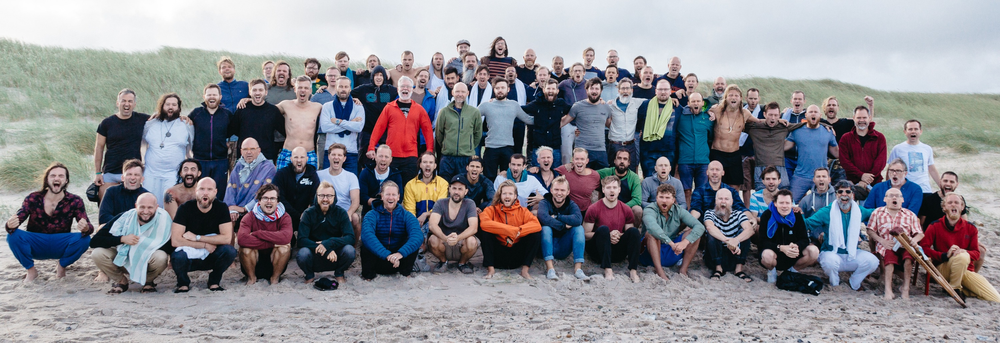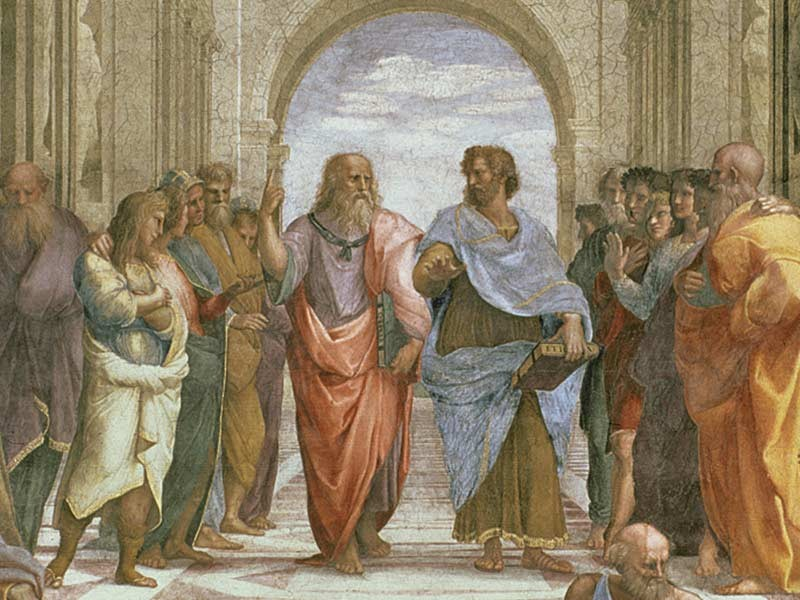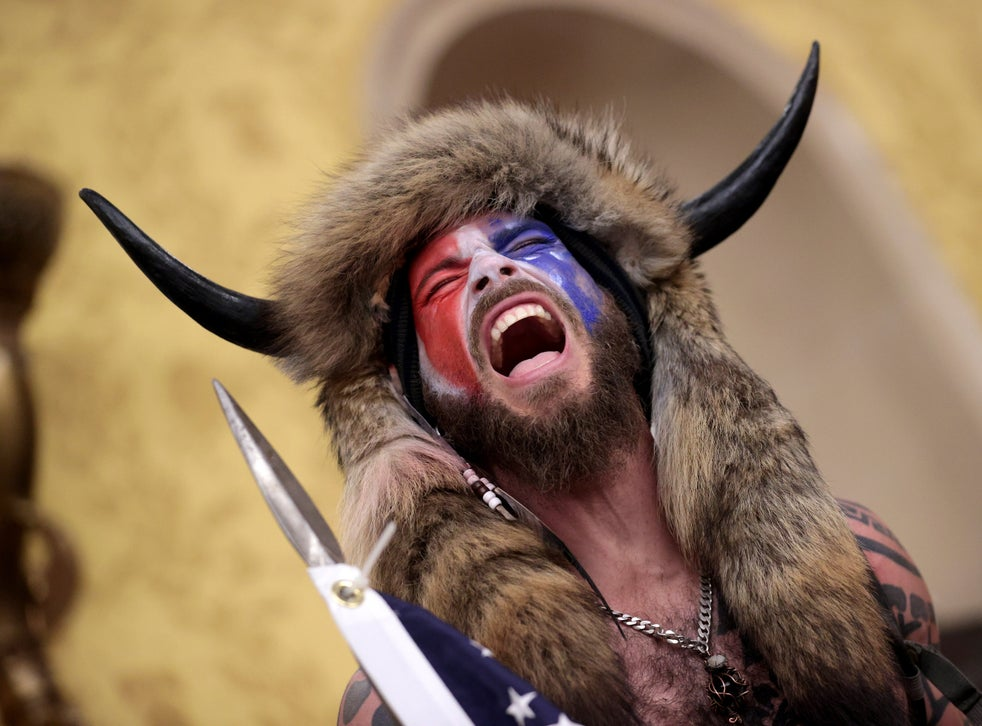All of Men’s Work Inside a Logo

This is the Maniphesto Logo.
Students of history will recognise the design as the same as the Spartan Shield.
When we created it, we were aware of the association with Sparta, but we mainly chose the symbols because we intuitively thought they were the right ones.
Since then over the years, as we have delved deeper into men’s work, I have come to appreciate the intuition. From these very simple lines, we can derive a lot more about Men’s Work.
So breaking things down, in the below, I will describe how the symbolism of this logo informs our work, starting with the very basics: a circle, a boundary, white space, a hierarchy, a left and a right side, two feet and a summit.
I also made a video discussing this topic, which you can see here:
A circle
The circle is fundamental to the Maniphesto way of working. It entails a flat and open communication field, where all are on an equal footing. It works best in situations where it is important to create depth and breadth, to harness the full wisdom of a group and to gain the deepest insight and truth possible. It also generally requires that there is ample time available. It is not suitable for situations where dynamic, agile and courageous decision making is required or where there is time pressure.
Much (but not all) of our groundwork with men is in circles. This is hence the fundamental organisational unit from the very top level of our European Men’s Leadership Summit to the individual weekly men’s network meetings.
Principle 5, “Conciliarity” in the 10 Principles of Maniphesto states that “Working as a council of peers brings Hierarchy and Do-ocracy together. We are co-creative by design, providing the platform for men to engage and contribute actively.”
The idea here is that we sit in a circle when we come together. “Conciliarity” is based on the format of the council – which is a meeting of peers, where no one member has an inherent higher authority than the others. Each individual man brings his own unique experiences, insights and perspective. Our value and the part each man has to play and contribute is dependent on the situation.
Of course it is important to note that, while we often sit in a circle, we are not relativists, and at any given point, each man can take the leadership of the circle – either to greater depth, or to less. Our society, and especially in Scandinavia where Maniphesto is born, then circles are far more popular than hierarchies. Tolerance and equality are held as the highest cardinal virtues, and hierarchy is regarded with scepticism if not seen as inherently oppressive in essence.
We take the positive aspects of flat, agile and trusting Scandinavian culture into our work, but we leave behind the “hierarchy phobia” which pervades many communities.
A boundary
The circle is also a boundary, which serves the function of delimiting an “inside” and an “outside”. At Maniphesto we have found that it is necessary to set up boundaries for our work and be completely explicit as to what needs to happen for you to be either inside or outside the organisation.
This process which entails excluding some and including others can be perceived as negative. Surely the men’s movement should be for “all men”? Who are we to decide which men should be included and who should be excluded? What about tolerance to those who are different from us?
Clear criteria, including certain people and excluding others, based on objective criteria is essential to create a sustainable organisation. With 8 billion people in the world, 4 of them men, providing the most specific, detailed and exclusionary criteria is the best way to create a strong foundation for men’s work. Note how this goes against the current societal trend that everything should be as inclusive as possible.
The boundaries for Maniphesto’s work, ranked roughly by their level of exclusiveness are as follows:
- You should be a man. You should also be certain of this and it should not require qualification. There are other groups and communities for transgender men as well as many other flavours. We support the creation of these. We are however an organisation for men’s work with men who are just “men”. If you need to seek approval of your specific definition of a man then you should not join.
In the beginning of our work, we engage some people in endless conversations on the exact definition of manhood. We have found that these conversations are not conducive to the type of work which moves us towards our vision of a new story about manhood, and have decided to keep them out.
- You should be ready to take responsibility for yourself. Every member of a community is a contributor to creating a culture of either responsibility or victimhood. Taking responsibility for yourself entails knowing who you are, what it is you want and where you want to go, and being proactive about moving your actual situation forward.
Taking responsibility entails accepting and even seeking input as to how we can improve. This is the most powerful way to learn and grow.
- You should be able to take care of your own needs – The men’s movement aspires to provide role models and set an example for manhood and society in general. Thus we welcome well functioning, integrated and embodied men who are able to take care of their own needs and are looking to be of service to others. It provides a catalyst for taking men from good to great. It is not a support group to rescue broken or lonely men. This is important work which we have a lot of respect for, but are not engaged with ourselves.
Men with serious mental illness, diagnoses or addiction issues should be sent to other relevant support groups.
- You should be “in transition” – Being in transition entails being aware that you are currently moving from one state of being or identity into another. There can be many states and reasons for this, including getting married, getting divorced, becoming a father or moving up to a leadership role at work. It can also be for all kinds of personal reasons that there is a need for a re-orientation and reevaluation of fundamental assumptions about yourself, about men and even reality.
In general, any major change of role requires a transition to adapt to being in that new role. We have found that the best time for men to engage in men’s work is once they have experienced relative success in life, reached their goals, and are now looking for “what’s next?” These men are typically looking for more meaningful projects to engage in where they can work with the issues that are closest to their own heart and often also contribute to others’ well-being and success.
- You should be looking for collaborators – We live in an individualistic society, where everything is about “me”. The work of the men’s movement needs to occur in a natural balance between the individual and the collective. For most of us, that entails engaging in joint action towards shared goals, committing to each other’s broader success in life and thus developing a life of meaning, purpose and bonds of friendship.
These are the boundaries of the men’s movement. The more that they are enforced, the stronger the community will become, the more inspiring we will grow, thus enabling ourselves to expand our impact and reach, inspiring an ever broader range of men with our vision.
The mechanism whereby these boundaries are upheld is threefold:
- First, through the onboarding and initiation rituals which we use to bring people into our community which repel people who are not in alignment with our values.
- Secondly, through the behaviour of the members of the leaders, which sets the tone and example for all other members to follow
- Lastly, through the standards that we set to create a culture of every single interaction whereby every one of the members are aware of how they are contributing towards striving together towards a common vision.
White space
Most of the logo is simply the white space – the space between the lines and shapes. Often we ignore white space and focus on the actual forms and lines. It is not easy to speak about – it is the invisible stuff between then things that are done and said – actually by talking about it, we sometimes ruin it.
It is relevant however to note that the white space is incredibly important to the shape and symbol. The white space is the space whereby the symbol appears. Without it, the symbol would be illegible and impossible. This is an abstract point, but a vital one to keep in mind in mens work.
In many wisdom and mystery traditions, then the feminine principle is often equated to this white space. If the masculine is equated to making a mark, to doing and action, then the feminine is the space or frame wherein that action occurs.
As men, we are often focused on form, function, strategy and tactics. Bringing our awareness to the frame or the white space can help us to reflect on the hidden assumptions and prerequisites for our coming together, the creation of the space of possibility in which our action occurs.
A hierarchy
The central figure of the logo is a lambda symbol, which is also a universal symbol of a hierarchy as an upside down “V”. We recognise that hierarchies are inevitable and natural. The more that we are able to be intentional and explicit about how our hierarchy is organised in our organisation, the more that we can ensure that it is organised after deliberate principles which contribute to the well-being of all levels of the hierarchy.
There is an increasingly powerful narrative in the mainstream of our society which claims that hierarchy is bad. This has its roots in a postmodernism. The feminist version associates hierarchy with patriarchy, which is seen as inherently oppressive. These narratives have largely taken over the sensemaking function of large portions of society, particularly areas such as media, politics and academia. This results in functional, merit-based hierarchies being left defenseless against erodation and replacement by dysfunctional ones.
On the surface, these new hierarchies will often be based on simplistic assumptions from identity politics. Under closer investigation, they are generally based on victim narratives of the strong oppressing the weak. They also contain reverse sexist, racist and other discriminatory ideas, even though they ironically posit themselves as being “anti-discriminatory” and place “tolerance” as their central value.
Part of the reason why these new narratives have had relative success in establishing new hierarchies are because they offer an alternative to the previous dominant narrative, whereby hierarchies were based on access to resources, such as money, power and status.
Many men find themselves increasingly alienated from their work and life from following a career which puts career development and earnings above all else. The Maniphesto approach is to intentionally and deliberately consider and work with which values our hierarchies are built by. Our existence is orientated towards our mission, to “Create a new story about men” by issuing a call to adventure to men who are in transition, and creating a supportive fellowship to find clearer meaning and purpose. The key principles in reaching that mission are detailed in our 10 Principles. These lay out the core values which determine progression in the hierarchy inside Maniphesto.
Being absolutely clear on the inherent values of our hierarchy and how men can progress upwards is vital for creating a healthy and sustainable organisation. Personal intrigues, power games and dramas occur everywhere that people come together. By being explicit about our values and also “practicing what we preach” through constantly listening to feedback, we are enabled to ensure that the surest and easiest way to progress up the hierarchy is as we intend it to be.
A left and a right and side
Dialectics is one of the fundamental principles of Maniphesto. There are always two sides to any situation and the dynamics of human interaction and meaning creation is dialectical. In our work, we find that the most interesting insights are found through the bringing together of differing perspectives – for example, those of the masculine and the feminine, politically conservative and progressive viewpoints, or eastern and western wisdom traditions.
All of us have natural biases in one direction or the other. An organisation which puts dialectics into its core principles ensures that hidden assumptions are challenged and that there is space for growth and development. An organisation which ignores the dialectical aspect of reality will generally be taken captive by an ideology, becoming an echo-chamber for people who agree with each other, and lose sight of the broader perspective.
This explains much as to why the political process in Western democracies is becoming increasingly meaningless for the broader population. Political parties are engaged in a power game, trying to solve problems using a simplistic and one-sided ideology which they apply to every situation. Thus we end up with two or more sides, half right and half wrong, and refusing to listen to each other – with dysfunctional government as the result.
Given the fact that men’s work is done exclusively with men, there is a greater need to nurture and strengthen feminine aspects, to avoid becoming overly structured, stiff and eventually tyrannical.
A dialectical approach is what can allow unity and multiplicity to exist at the same time in one organisation and thus enable members to move towards true individuality instead of just copying a leader. We have found it is important to respect the man and challenge the idea, to admire each other’s gifts and to approach disagreement with curiosity and mutual respect. By engaging in dialectical discussion, we grow in discernment and insight.
Two feet
Change is happening faster than ever these days – philosophers and thinkers have speculated over how the information explosion and the dissolution of space through ubiquitous connectedness of modern society is causing time itself to be speeding up. Certainly this is the perception of most people, that the new media paradigm is causing a flood to wash over us, and the need for a firm foundation is greater than ever.
The principles of Maniphesto underline that the paradigm shift to an increasingly digital society requires visionary, strong and responsible men, grounded on a strong foundation, to step up in formulating new paradigmatic principles which foster lives of freedom, integration, meaning and well-being.
But what do we mean by a “strong foundation”, and how can we agree on a which traditions, ideas or processes are good enough? Science seems to be the most credible source for many people today, and yet science is explicit in that it is value free, and does not differentiate between the virtue of the atomic bomb or the solar panel. We need a foundation which can encompass questions of values, ethics and even morals.
There are no shortcuts to “standing on your own two feet – it entails building a strong foundation. In order to know where we are going, we need to know where we come from. In the field of men’s work, we find it appropriate to frame this as “knowing your father”. This entails having spent time getting to know, understand and appreciate the background of your biological father. And it also means getting to know the people, who are the originators or “fathers” of all of your communities, organisations, interests, ideologies, philosophies and religion if you have one. In short it is about being well versed in your own past and where you and all around you actually comes from – in an intimate and personal way – as opposed to an intellectual, academic way. See our blog post on “Finding your Ur-father” for more on this.
Maniphesto is a fairly unique organisation in that we have direct and honest conversations about philosophical perspectives and religions, their various strengths and weaknesses, and are certainly not relativists. On the contrary, we believe that fostering a discussion around concepts such as truth, beauty love and joy, referring to religious and philosophical perspectives is a vital element of men’s work, in order to create a stronger foundation, so we can stand on both feet to face the oncoming flood.
A Summit
While Maniphesto is not relativist regarding religious and philosophical perspectives, then we refrain from defining a specific and personalised shared summit as the pinnacle of wisdom or truth which is applicable for all of us. While different teachers and facilitators in Maniphesto generally have their own personal “summit”, they will differ from being different figures, such as Christ, the Buddha, Zoarasater or Freud.
Obviously this diversity could result in a cacophony of differing and often conflicting perspectives. The way that we deal with this is to define the summit of our work as “silence”. In practical terms, this means that at the end of the day, the simple pleasure of being together with men that we respect, trust and appreciate, without words, is far stronger than all the philosophical discussions. We as men can be together,
From a more philosophical perspective, the “silence of the summit” can be referred to as the “apophatic approach” or the path of negation – defining the divine by saying what it is not. This understanding lies at the roots of all deep, contemplative wisdom traditions and is often described as “the divine darkness”. It reflects a respect of the indefinability of the transcendent and the failure of words to describe the mysteries of existence which are beyond our comprehension.
The fact that over 95% of the world’s philosophers are men is an indication that men have a greater tendency to dedicate themselves without compromise to reaching transcendent truths. When we experience a breakthrough, an insight or a revelati+on, then the summit of silence is generally the approach whereby we can most appreciate the love shared in a fellowship of men as brothers.





Responses